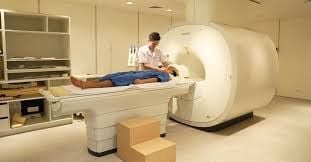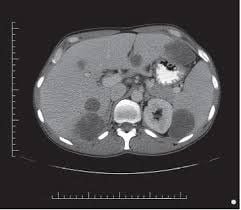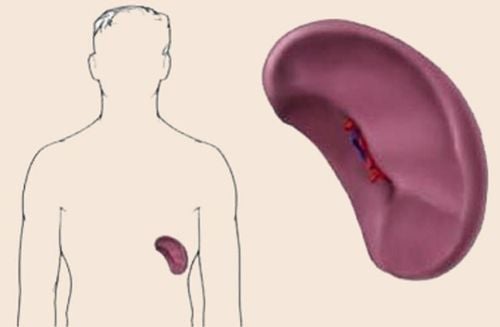This is an automatically translated article.
The article is expertly consulted by Master, Doctor Nguyen Thi Mai Anh - Doctor of Radiology - Department of Diagnostic Imaging and Nuclear Medicine - Vinmec Times City International General Hospital. Doctor Nguyen Thi Mai Anh has nearly 10 years of experience in the field of diagnostic imaging, especially in imaging breast and thyroid cancer.The spleen is the largest lymphatic organ in the human body and is responsible for central hematological and immunological tasks. The spleen can be affected by other diseases such as spleen injury, spleen tumor,... At this time, computed tomography is a useful tool to help detect abnormalities in the spleen.

Chụp chẩn đoán hình ảnh trên chụp cắt lớp vi tính lách
1. Overview of imaging on computed tomography of the spleen
The anatomical features of the size and shape of the spleen are quite variable in the general population. At the same time, the true shape of the spleen can also be influenced by adjacent organs, so determining the normal size of this organ can be difficult. At this time, the interpretation of some lesions in the left hypochondrium in general, in the spleen in particular, in addition to the signs obtained through clinical examination, imaging tools will have a supporting role, in which Computed tomography is a highly effective method.On non-contrast CT images, the spleen of a healthy person usually has a mean maximum length of 10 cm and a density of about 45 Hounsfield Units. Lesions in the lower ribs, localized to the spleen are common findings on abdominal computed tomography images. Although the majority of suspicious findings such as splenomegaly do not require specific management or monitoring, some other splenic findings warrant closer attention, such as splenic trauma.
The following is a detailed description of imaging studies on computed tomography of the spleen in common pathologies.

Chẩn đoán hình ảnh trên chụp cắt lớp vi tính lách
Splenic cysts can be divided into two large groups as true cysts and pseudocysts. While true splenic cysts have an epithelial lining, the wall of a pseudocyst is composed of dense fibrous tissue without epithelial lining.
A high-resolution computed tomography scan of the spleen can help differentiate between true splenic cysts and pseudocysts. However, in clinical practice, this distinction is often unnecessary because the cyst can be viewed as a benign lesion, especially when there is a dark border around it. Even so, cysts in the spleen can still cause complications, including infection, rupture, and hemorrhage, which in turn can cause clinical symptoms such as fever, left upper quadrant pain, or jaundice. Therefore, periodic monitoring of the cyst may be necessary, especially when the patient has symptoms in the left hypochondrium.
Injury to the spleen
The spleen is a vascularly rich organ that receives up to 5% of cardiac output and holds about 500 ml of blood reserve. In blunt abdominal trauma situations, the spleen is the most commonly affected organ. Due to its thin anatomical structure, fixed by loose ligaments, trauma to the spleen has the potential to lead to massive unexplained bleeding.
At this time, a contrast-enhanced computed tomography scan is an excellent imaging modality for evaluating traumatic lesions of the spleen. However, care should be taken not to misinterpret congenital malformations of the spleen such as splenic rupture or splenic incision for splenic trauma.
Before the injection phase, non-contrast CT images of the spleen can distinguish bleeding in the spleen from the form of fluid in the parenchyma, subcapsular or perisplenic fluid. However, when contrast is injected into the body, an acute bleeding spot with contrast extravasation can be observed. At the same time, around the tears in the spleen are areas of impaired splenic perfusion, limiting contrast to these parenchymal areas.
Splenic abscess
Splenic abscess is classified as pyogenic, fungal and tuberculosis. In which, on computed tomography scan of the spleen with contrast, the pyogenic abscess is usually single-focal, showing "infiltration of the border" of the outer part of the abscess wall. Intramural sections often have poorly enhanced or non-enhanced components due to necrosis. The fluid within the pyogenic splenic abscess is usually of heterogeneous density.
In contrast to pyogenic abscesses, splenic fungal abscesses are mostly multifocal and smaller in size, and do not show border enhancement on contrast-enhanced computed tomography (CT) images of the spleen. However, because of their small size, fungal abscesses can sometimes be difficult to detect.
Tuberculous abscess of the spleen is a collection of multiple splenic lesions at the same time, small in size in association with hypersplenism. Simultaneously, computed tomography of the spleen may also show extension of a tuberculous lesion in the abdomen.

Lách là cơ quan bạch huyết lớn nhất trong cơ thể con người
In sickle cell disease, because the shape of the red blood cells changes, this will lead to microinfarction and microhemorrhage in the spleen parenchyma seen on micrographs. Contrast-enhanced spleen as a small, diffuse, unspecified lesion.
Also, in the early stages of the disease, radiographs can detect an enlarged spleen. As the disease progresses, the spleen becomes increasingly dysfunctional, shrinks, and may become calcified with multiple small splenic lesions of low intensity due to sickle cell splenic infarction.
Splenic infarction
Splenic infarction is caused by lack of perfusion of certain areas of the spleen or an entire organ. The most common cause of splenic infarction is partial or total occlusion of the splenic artery or its branches.
On contrast-enhanced computed tomography scan, splenic infarction appears as a wedge shape, with a hypodense area with a background opposite the splenic cyst. Increased perfusion entering the affected area can be observed on delayed phase imaging. At the same time, if splenic infarction progresses, it will cause a secondary abscess or rupture of the spleen and hemorrhage into the abdomen.
Splenic hemangioma
Hemangioma is the most common primary benign vascular fibroma, not only in the spleen but also in other solid organs such as liver and kidney.
On unenhanced splenic tomography, most hemangiomas are mild or hypertrophic when compared with normal splenic parenchyma. After contrast, hemangiomas often present early, with peripheral nodular proliferation, extending toward the center of the well-defined lesion over time.
In addition, during follow-up, splenic hemangiomas can sometimes change in size, become slightly larger or smaller, as well as develop additional complications, most importantly - although very Rarely - spontaneous rupture, which can lead to extensive intraperitoneal hemorrhage.
Lymphoma of the spleen
Lymphangiomas of the spleen are often discovered incidentally in children and young adults. They are usually located near the splenic cysts and may be single or multiple.
On contrast-enhanced computed tomography, lymphangiomas present as well-defined lesions, possibly with focal scarring on the vessel wall.
Sarcoidosis
Sarcoidosis is a systemic granulomatous disease of unknown cause that can affect many organs and locations on the body, also often involving the spleen.
On computed tomography of the spleen with contrast, the most important finding in a patient with sarcoidosis is splenomegaly. However, imaging may also show small lesions that are less signal-intense than healthy splenic parenchyma, with no clearly defined limits for contrast enhancement. In addition, hilar lymphadenopathy is an important finding suggesting the diagnosis of splenic sarcoidosis.
Lymphoma
Lymphoma represents the most common malignancy of the spleen. In patients with lymphoma, the spleen is the next most commonly involved site, causing splenic cancer.
Contrast computed tomography of the spleen can be difficult to distinguish a lymphoma nodule from sarcoidosis or a fungal abscess. This lesion is best associated with a patient with a history of immunocompromised lymphoma. Another distinguishing feature of malignant splenic lymphoma is the presence of enlarged lymph nodes.
Spleen metastasis
Cell metastasis to the spleen often occurs in the setting of metastatic terminal cancer. Carcinomas of the breast, lung, ovary, colorectal, and stomach, as well as skin melanoma, are identified as the most common sources of primary malignancy.
On non-contrast computed tomography, metastatic lesions to the spleen may present as hypoattenuation. In contrast, on contrast-enhanced tomography, the lesions enhanced enhancement. In addition, abdominal computed tomography showed signs of invasion of the portal vein or other organs.
In summary, computed tomography of the spleen is a tool to help diagnose the spleen with high sensitivity and specificity. However, to accurately interpret spleen lesions, the physician also needs to evaluate in the clinical context of the medical history and history, because computed tomography images can still overlap. differential diagnosis or the need for repeat imaging to monitor disease progression over time.
Vinmec International General Hospital is one of the hospitals that not only ensures professional quality with a team of leading medical doctors, a system of modern equipment and technology. The hospital provides comprehensive and professional medical examination, consultation and treatment services, with a civilized, polite, safe and sterile medical examination and treatment space.
Please dial HOTLINE for more information or register for an appointment HERE. Download MyVinmec app to make appointments faster and to manage your bookings easily.
Article referenced source: NCBI












